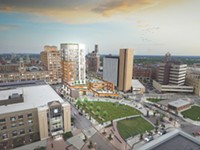[
{
"name": "500x250 Ad",
"insertPoint": "5",
"component": "15667920",
"parentWrapperClass": "",
"requiredCountToDisplay": "1"
}
]
For more on this topic: See Mary Anna Towler's "City should turn down University Ave. project" in this week's Urban Journal.
This is a corrected version of this story.
If you've been trying to track down Rochester Mayor Tom Richards, odds are good you can catch him at a ribbon cutting. Voters Block, Bridge Square, Frederick Douglass, Carriage Factory.... Richards and a revolving cast of supporting characters have been snipping their way around the city, welcoming each new addition to Rochester's seemingly endless parade of apartment projects.
And with the eventual redevelopment of the Sibley building, Midtown Tower, and many other projects in various stages, the mayor is well-advised to keep the scissors, and maybe a good pair of running shoes handy.
But how many apartments are too many? The population of Monroe County as a whole is not and has not been growing at a significant rate, and one of the entrenched problems facing the City of Rochester is that it's overbuilt — too much housing, not enough people.
So who's going to live in all these new apartments, lofts, townhouses? Experts say it's you, the empty nester, looking to downsize to a simpler lifestyle. And you, the millennial, who's rediscovered the allure of urban living. And you, average guy, who isn't satisfied with the older housing stock available; you want the latest and greatest.
The suburban market is much harder to get a handle on because it's not really a "market" so much as 29 individual towns and villages, each with its own distinct market and submarkets. Henrietta is seeing a real trend of residents looking for apartments and has several projects under construction or in the pipeline, says town Supervisor Mike Yudelson. And a Brighton official says residents there are increasingly asking for different housing options.
But what are the consequences of building, building, building when the population is essentially stagnant? Are you just shuffling people around, stealing residents from one town or one part of the city to populate another? What happens to the towns and city neighborhoods on the losing end?
And with no regional mechanism to plan or track development, how do you know when you hit a saturation point? At least one local developer has pulled out of the suburban market altogether, saying demand was drying up. The demand in the city is strong, he says, for now.
"You do have this new, nascent trend of demand that is directly centered around the City of Rochester," says James Costanza, president of Costanza Enterprises, a local real estate management and investment firm. "And you've had dozens of new rehab projects, where you've taken old buildings and you've created new apartments. That demand is still healthy. But one asks, when does this healthy trend become unhealthy and unbalanced with too much supply? And frankly, I'm not sure I have the answer to that."
A complex web is driving the City of Rochester's apartment boom. One factor is household formation, which, simply put, is the number of households in existence. Fewer households were formed during the recession, but that number, by many accounts, seems to be bouncing back. Young people afraid to leave the nest because of the shaky economy are crawling out of their parents' basements to strike out on their own.
And more people have been holding off on marriage, getting married much later in life than they did 20 years ago, says Kent Gardner, chief economist and chief research officer for the Center for Governmental Research. Those people are starting to show up in the housing numbers.
"So part of it is pure demographics," he says. "There are more housing units needed because there are more separate households."
The other issue, he says, is market demand for a more diverse housing stock. Data shows that retiring baby boomers are in large measure looking to dump the single-family home for townhouses, condos, or patio homes, Gardner says.
"And because we've got this great big bulge of baby boomers entering retirement age now, a lot of what's going to be happening in the residential housing market is going to be a shift toward different housing stocks," he says.
And city officials say there's also a shift occurring in household demographics in that households are much smaller than they used to be. Over the next two decades, more than 80 percent of new households formed will be one- and two-person households, says Heidi Zimmer-Meyer, president of Rochester Downtown Development Corporation. And that's the prime demographic for the new urban lifestyle, she says.
"These new adults-only households won't give a hoot about the quality of local schools or the size of their back yards," writes Jeff Speck in his 2012 book, Walkable City.
Millennials, the generation born in the late 1970's or early 1980's to the early 2000's, represent the biggest population bubble in the United States in 50 years, Zimmer-Meyer says, and 77 percent plan to live in America's urban cores.
"Pop culture is driving some of this, and tastes and desires have been changing," she says. "More people want authenticity in their housing and neighborhoods; density now has currency in the housing market. More people want walkable, culture-rich environments to live in."
But it's more than millennials and baby boomers. Young professionals, artists, students, wealthy retirees, and childless couples are also exploring housing options in the city.
"You can't ignore the fact that people are looking for different types of amenities, different types of units, loft-style living, living on the river," says Bret Garwood, the city's director of business and housing development.
The growth, though, with some exceptions is disproportionately tilted in favor of the downtown area. The City of Rochester as a whole lost 4.2 percent of its population from 2000 to 2010, according to Census figures, but downtown's population grew by 11.5 percent. A healthy rental market has about a 5 percent vacancy rate, Garwood says. The city's total vacancy rate is around 11 percent, he says, while downtown's vacancy rate is between 3.2 percent and 4.2 percent. (Overall, though, the city's vacancy rate dropped slightly from 2000 to 2010).
Downtown Rochester now has approximately 5,000 residents with 36 buildings that have been or are being converted from commercial use to housing since 2000. And 89 percent of those rental units lease in three months or less, Zimmer-Meyer says.
"We have no trouble, no trouble at all filling up good housing," says Mayor Richards.
There are pockets of demand outside of downtown, he says, such as in the South Wedge, where development is being driven by the neighborhood's proximity to the University of Rochester. Demand from the UR is also the reason for the new Brooks Court subdivision on Genesee Street in the 19th Ward. Other parts of the city seeing increased property values include the Highland Park neighborhood, Park Avenue, College Town area on Mount Hope, and the Neighborhood of the Arts.
While all of this development is planned or taking place, the City of Rochester is stepping up the number of vacant houses it tears down. There are approximately 2,500 vacant structures in the city, Garwood says.
Rochester is built for a population exceeding 300,000 residents, Richards says, but currently about 210,000 people live within the city limits.
"There's a dichotomy here, and it seems like a conflict if you look at it from a distance," Richards says. "We're tearing down properties at the same time we're building others."
But it's not a one-for-one discussion, Garwood says. The vacant properties are often in bad shape and located in less-than-desirable neighborhoods. The bulk of the city's housing stock was built in the early 20th century, Richards says, and the properties are often small and lack garages and driveways.
Nobody would buy those houses even if there was never another house or apartment complex built in the city, Garwood says.
"There's not a direct connection there," he says. "If we just decided we're not going to [build], that's not going to keep more of our homes from going vacant. It's not going to solve our problem with vacant single-family homes in the northeast and the southwest and the northwest [quadrants]. If we don't build for the market that's emerging, all that's going to happen is we're going to miss capturing some of that market. That would be catastrophic."
The factors the city uses to determine the strength of the housing market are the vacancy rate, how quickly new units are leased, and the price of rent. And in downtown as well as in targeted neighborhoods, Garwood says, those indicators are generally strong.
"We could overbuild," he says. "We need to be sensitive to that. We need to monitor it. We don't want to just develop new housing to eat the lunch of the existing."
Developers, as to be expected, tend to have a different, less-altruistic way of looking at it. They make money by leasing units, and if they can steal your tenants by offering them things you can't or won't, well, then, they say, you lose.
"People move for a variety of reasons, but it's definitely what I would classify as a zero-sum game in the macro area," says Larry Glazer, CEO of Buckingham Properties, a local real estate development and property management company. "If I rent one apartment to somebody, somebody else is going to lose them. But maybe they're losing because they weren't doing a good job. That's life, folks. That's what happens."
Nobody likes a vacant, derelict house; it junks up the street and attracts troublemakers.
But if you keep demolishing without building anew, you end up with near-empty neighborhoods that hardly seem worthy of the name.
Buffalo, for example, has pursued an aggressive demolition policy over the last 20 years, says CGR's Gardner, and the results are visually striking.
"As you come east from downtown, you go through neighborhood after neighborhood, you see many blocks where there seems to be only maybe 20 percent of the buildings still standing," he says. "It's very difficult, I think, to support a neighborhood when you've got that much vacant land. If we become this gap-toothed community with only a few houses left standing on a particular block, how is that neighborhood ever going to come back?"
RDDC's Zimmer-Meyer says the hope is that by securing "funnel points" for middle-class families to move back to the city — downtown, for example — it will lift up the entire city.
"[That] we will see greater fiscal stability for the city as a whole, which will create more opportunities to effectively impact the toughest, most challenged city neighborhoods and the families who live in them," she says.
But building anew is not a panacea for a region that's not growing, Garwood says. Some of Rochester's neighborhoods have such extreme problems with poverty, crime, high vacancy rates, low rates of owner occupancy, and low property values — homes may sell for as little as $10,000 or $20,000 — that inserting new units into those situations won't help. What do you do?
Garwood says you start by finding solutions that fit individual neighborhoods; there is not a one-size-fits-all approach. In some neighborhoods, beefing up the commercial corridors might help. In others, maybe the city could assemble enough land to create a community asset like a park, or a pocket of light manufacturing activity.
Instead of a neighborhood that's largely vacant, you demolish the derelict housing, Garwood says, and build better-quality housing, strategically. The city is attempting to implement this vision in the JOSANA neighborhood in Rochester's northwest quadrant.
JOSANA is in Rochester's infamous "crescent" and has for many years been considered one of the city's most troubled neighborhoods in terms of crime, drugs, poverty, vacancies, and other indicators.
In 2011, the City of Rochester put together a master plan to improve the social network of the neighborhood, and to boost public safety, public health, and job creation. Housing is a major component of the vision.
"The goal there is to get some density along Broad Street and inward," Garwood says. And then around School 17, "try to target Habitat and other infill housing to get owner occupancy really surrounding that school, and re-establish the fabric of the neighborhood around the school and around Broad Street."
At the same time, you accumulate parcels of land in other parts of the neighborhood to create green space for a neighborhood amenity, Garwood says, or for a future economic development project.
But the point is that when the work in JOSANA is complete, he says, it won't have any more housing than it does now.
The city is also participating in the Project Green program, where plans are to convert more than three dozen city blocks to green space over the next 20 years for use as community gardens, urban farms, parks, and renewable energy generating facilities.
And the city recently won approval from New York State to form a land bank: a nonprofit corporation that can help streamline the city's approach to dealing with vacant, abandoned, and tax-delinquent properties.
Brighton and Henrietta officials say they are seeing some of the same trends in their housing markets as are occurring in the city. The trend toward apartment living reflects people wanting to simplify, says Henrietta Supervisor Yudelson. In other cases, the units are aimed at young professionals or people looking for more modern, up-to-date housing.
A former Henrietta meat-packing facility on Brighton-Henrietta Town Line Road is being converted for apartments, there's a proposal for a complex with more than 200 units near the Rochester Institute of Technology campus, and Graywood Meadows between East River Road and the Genesee River will consist of a couple of hundred units of single-family houses, townhouses, and apartments, to name three projects.
"All these different developers are coming, telling me there's definitely a market for this," Yudelson says. "We have several projects either under construction or in the pipeline. Some are fairly large and some more modest."
Apartments used to be a cheaper alternative to houses, he says, but now they're more a lifestyle choice.
Brighton town planner Ramsey Boehner says residents there want more housing options, too: something other than the big single-family house. The retiring baby boom generation, young people attracted to urban living, and others who live active lifestyles want their services in walking distance, Boehner says. Suburban developers are trying to capitalize on the "urban renaissance," he says, by incorporating into their projects the features that draw people to cities.
"You're seeing more mixed-used projects," Boehner says. "You're mixing it, making it more walkable, more sustainable, connecting it to trails, and those types of things."
An example, though it may be an extreme one, is Brighton's 63-acre Reserve on the Erie Canal: 327 units of townhouses, patio homes, executive lots for custom homes, and brownstones in six buildings on the canal. There will be a clubhouse with a movie theater, dining room, exercise area, and a wine cellar. And the Reserve will have a dock for canal touring boats and another dock for kayaks and canoes.
The project will be broken up into six distinct "neighborhoods," says Anthony Costello, chair and CEO of Anthony J. Costello and Son, a Rochester real estate development and property management firm. The neighborhoods will be connected by a trail running through the property.
"It's a walkable neighborhood," Costello says. "There's a big pent-up demand for this type of housing, and there's a pent-up demand in Brighton. Brighton has not had any new development for, like, 35 years. The average home is over 71 years old."
Another example is the Brickstone senior housing project on Elmwood Avenue. The mixed-use complex has retail, restaurants, bungalows, townhouses, lofts, and apartments. It's also connected to a trail system and a sidewalk system.
"It's a dense project, which is another feature of urban planning because you're not using as much open space," says Brighton's Boehner.
But not everyone is sold on the suburbs. Costanza Enterprises sold its suburban portfolio — about 1,000 apartment units — in 2007. Company president James Costanza says he saw a distinct and difficult-to-counteract trend happening.
"Our ability to raise revenues was severely limited and our operating expenses — typically insurance, utilities, and taxes — were going up in double, and in some cases triple digits," he says. We had a very real ceiling on rent increases, mainly because the demand for the apartments was limited."
It was limited because of the county's static population, he says, and because of the demographic he was aiming for: young people just starting out on their own. Young people need jobs to pay the rent, Costanza says, and Rochester and New York State haven't been kind in that area.
The people with the cash to make rent payments — "tax generators," Costanza calls them — have been leaving the state, he says, while the number of "tax consumers" — the older generation — is growing.
"So it's kind of an upside-down pyramid," Costanza says. "We decided to sell our portfolio in the suburbs because of that trend. And there have been others who have done the same thing over the course of the last decade."
But Costanza says he sees hope in the local start-up and high-tech communities, as well as the growing number of jobs provided by the area's colleges and universities. And the jobs situation at Rochester's "celebrity" businesses — Kodak, Xerox, and Bausch & Lomb — seems to be stabilizing, Costanza says.
"If you can't sustain and you can't grow your younger demographic, you're going to at some point run into a mathematical economic problem," Costanza says. "Ultimately it gets back to demographics and can we continue to grow those demographics? And the answer is, if we can continue to create businesses and jobs, we can."
Speaking of...
Latest in News
More by Christine Carrie Fien
-

Building up
Mar 29, 2017 -

Hetsko's heart
Mar 15, 2017 -

Squeezing starts at GateHouse-owned Daily Record and RBJ
Feb 28, 2017 - More »

![[ Slideshow ] Rochester's Apartment Boom](https://media1.roccitymag.com/rochester/imager/a-kitchen-in-the-temple-building/u/inlineslideshow/2220110/apartmentboom-01.jpg)
![[ Slideshow ] Rochester's Apartment Boom](https://media1.roccitymag.com/rochester/imager/the-temple-building-on-franklin-street-is-billed-as-manhattan-style-living/u/slideshowthumb/2220111/apartmentboom-02.jpg)
![[ Slideshow ] Rochester's Apartment Boom](https://media1.roccitymag.com/rochester/imager/a-hallway-in-the-temple-building/u/slideshowthumb/2220112/apartmentboom-03.jpg)
![[ Slideshow ] Rochester's Apartment Boom](https://media2.roccitymag.com/rochester/imager/james-costanza-president-of-costanza-enterprises-inside-the-temple-buildi/u/slideshowthumb/2220113/apartmentboom-04.jpg)
![[ Slideshow ] Rochester's Apartment Boom](https://media2.roccitymag.com/rochester/imager/inside-the-temple-building/u/slideshowthumb/2220114/apartmentboom-05.jpg)
![[ Slideshow ] Rochester's Apartment Boom](https://media1.roccitymag.com/rochester/imager/inside-the-temple-building/u/slideshowthumb/2220115/apartmentboom-06.jpg)
![[ Slideshow ] Rochester's Apartment Boom](https://media2.roccitymag.com/rochester/imager/larry-glazer-ceo-buckingham-properties-says-rochesters-apartment-market/u/slideshowthumb/2220116/apartmentboom-07.jpg)
![[ Slideshow ] Rochester's Apartment Boom](https://media1.roccitymag.com/rochester/imager/buckingham-commons-on-allen-street-features-one-bedroom-loft-apartments/u/slideshowthumb/2220117/apartmentboom-08.jpg)
![[ Slideshow ] Rochester's Apartment Boom](https://media1.roccitymag.com/rochester/imager/inside-buckingham-commons/u/slideshowthumb/2220118/apartmentboom-09.jpg)
![[ Slideshow ] Rochester's Apartment Boom](https://media1.roccitymag.com/rochester/imager/inside-buckingham-commons-a-glazer-property/u/slideshowthumb/2220119/apartmentboom-10.jpg)








